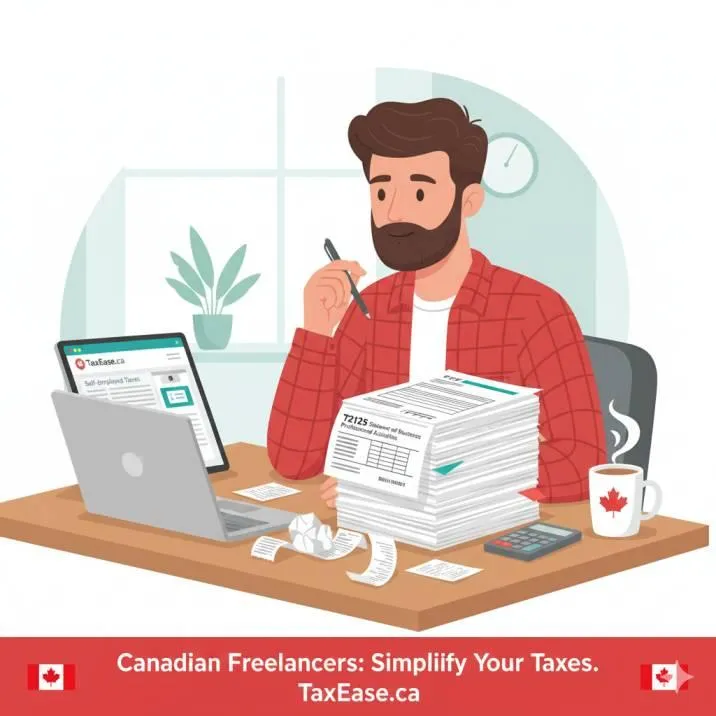Learning Center


The Ultimate Guide to Filing Taxes for Self-Employed Canadians
Why Self-Employed Taxes in Canada Feel Overwhelming
If you’re a freelancer, contractor, or small business owner, you’ve likely asked: “How do I file my self-employed taxes in Canada without missing deductions or facing CRA penalties?”
Unlike employees, self-employed Canadians must track income, pay CPP contributions, and claim business deductions through the T2125 form. The process can feel daunting, but with the right strategy, you can file your taxes, maximize deductions, and keep more of your hard-earned money.
At Taxease, we’ve helped thousands of Canadians file confidently with tools like our TaxEase Self-Employed Tax Software—tailored for freelancers, gig workers, and sole proprietors.

Step 1 – Understanding How CRA Taxes the Self-Employed
Unlike salaried employees, self-employed workers in Canada file taxes using:
T1 General Return (personal tax return)
T2125 Statement of Business or Professional Activities (to report business income/expenses)
👉 This means you pay income tax + CPP contributions on your net business income.
Self-Employed CPP Contributions
As a sole proprietor, you pay both the employer and employee portions of CPP, totaling 11.9% (2024 rates) on income up to $68,500.
👉 Pro Tip: Always set aside 25–30% of your income for taxes and CPP so you don’t get caught short at tax time.

Step 2 – Filing T2125 Canada (Business Income & Expenses)
The T2125 form is where you declare your gross business income and claim expenses to reduce taxable income.
Common Categories on T2125
Gross business/professional income
Advertising and promotion
Office supplies and software
Meals and entertainment (50% deductible)
Travel and vehicle expenses
Professional fees (legal, accounting, software like TaxEase)
👉 Example: If you earned $60,000 freelancing but had $15,000 in deductible expenses, you’ll only be taxed on $45,000.

Step 3 – The Self-Employed Tax Deductions You Can’t Afford to Miss
Claiming the right deductions is the key to lowering your tax bill. Here’s the Canadian business tax deductions list many freelancers overlook:
Highest-Value Deductions for Self-Employed Canadians
Home Office Deduction Canada: Claim a portion of rent, mortgage interest, utilities, and internet.
Vehicle Expenses: Gas, insurance, repairs—must keep a mileage log.
Phone & Internet: Business-use percentage.
Capital Cost Allowance (CCA): Depreciation on laptops, furniture, equipment.
Professional Development: Courses, certifications (even CRA’s Canada Training Credit).


Step 4 – GST/HST Rules for the Self-Employed
If you earn over $30,000 in a 12-month period, you must register for a GST/HST number.
You charge GST/HST on invoices.
You remit it to CRA quarterly or annually.
You can claim Input Tax Credits (ITCs) on business purchases.
👉 Many new self-employed Canadians miss registering on time, which can lead to CRA penalties.

Step 5 – Deadlines & Avoiding CRA Penalties
Self-employed Canadians get an extended tax filing deadline:
Filing Deadline: June 15, 2025 (extended to June 16 since the 15th is Sunday).
Payment Deadline: April 30, 2025.
👉 Even if you file in June, taxes owed must still be paid by April 30 to avoid interest.
Common CRA Penalties Self-Employed Canadians Face
Late Filing Penalty: 5% of balance owing + 1% per month.
GST/HST Late Remittance Penalties.
Over-contributions or false claims on deductions.

Step 6 – Tax Filing Software & Professional Help
While some freelancers still file on paper, the fastest way is using certified software like TaxEase Self-Employed Tax Software.
Benefits of filing online:
Automatically fills T2125.
Guides you through self-employed deductions.
Syncs with CRA for secure NETFILE submission.
Saves hours of manual calculations.
👉 Pro Tip: If your business is growing fast, consider consulting a tax professional to set up incorporation or advanced tax planning.

Real-Life Scenario – A Freelancer Filing Their First Self-Employed Taxes
Meet Sarah, a Toronto-based graphic designer. She made $65,000 in 2024, with $12,000 in expenses.
Gross Income: $65,000
Deductible Expenses: $12,000
Net Income: $53,000
Taxes + CPP: ~$14,000 (after deductions & credits)
👉 By carefully tracking her home office, vehicle mileage, and professional courses, Sarah reduced her taxable income significantly. Filing with TaxEase, she avoided mistakes and saved nearly $4,000 in taxes.

Quick Self-Employed Tax Filing Checklist
Before you submit your return, ensure you have:
All business income invoices & receipts.
Mileage log (if claiming vehicle expenses).
Home office expense records (square footage, bills).
Proof of professional development/training.
CRA GST/HST filings (if registered).
A set-aside tax fund (25–30% rule).

Filing Taxes as a Self-Employed Canadian Doesn’t Have to Be Hard
Filing self-employed taxes in Canada may feel complicated, but with the right approach, you can file your T2125, maximize deductions, and avoid CRA penalties.
Whether you’re a freelancer, consultant, or small business owner, staying organized throughout the year is the best tax-saving strategy.
At Taxease, we simplify the process with smart filing software and expert guidance so you can focus on growing your business—not stressing about taxes.
👉 Ready to file your self-employed taxes stress-free? Start with Taxease today and maximize your return with confidence.
TaxEase.ca is a Canadian tax preparation and accounting firm serving individual and corporate clients Canada-wide.
Useful Links
©2025 . All Rights Reserved.
